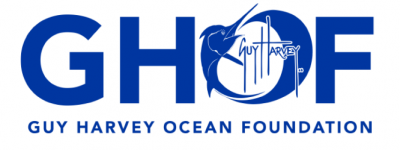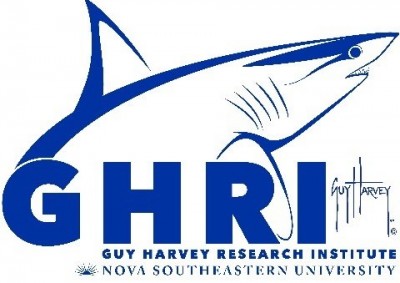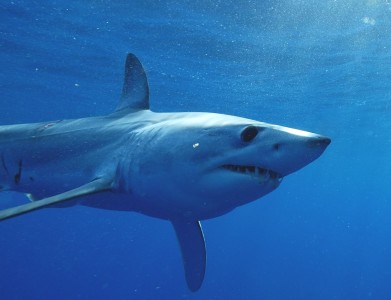NSU Newsroom
SharkBytes
Horizons
This version of NSU News has been archived as of February 28, 2019. To search through archived articles, visit nova.edu/search. To access the new version of NSU News, visit news.nova.edu.
This version of SharkBytes has been archived as of February 28, 2019. To search through archived articles, visit nova.edu/search. To access the new version of SharkBytes, visit sharkbytes.nova.edu.
Tagged Mako Shark Takes Amazing 13,000 Mile Journey
It Is The Longest Journey Ever Tracked In The Atlantic Ocean
FOR IMMEDIATE RELEASE
FORT LAUDERDALE/DAVIE, Fla. – A male mako shark named Hell’s Bay has broken a record, traveling more than 13,000 miles, equal to over half-way around the planet, in 600 days. It is the longest track ever in the Atlantic Ocean by a mako shark tagged by researchers in Nova Southeastern University’s (NSU) Guy Harvey Research Institute (GHRI)
“We’ve had some of our tagged makos take some pretty interesting tracks over the years, but this one swims above the rest,” said Mahmood Shivji, a professor at NSU’s Halmos College of Natural Sciences and Oceanography and the Director of NSU’s GHRI. “Having Hell’s Bay report for as long as he has is fantastic because we’re able to really get a detailed look at mako migration behavior over a good amount of time. He was like the Energizer bunny – he kept going and going and going, and luckily did not get captured like many of our other sharks.”
The 600-day track of Hell’s Bay mako can be seen ONLINE at nova.edu/sharktracking (select Project 3 under the Mako Shark section.)
Hell’s Bay was tagged in May 2015 off the coast of Ocean City, Md. In the first year, Hell’s Bay traveled north along the east coast and then returned close to the tagging site. Hell’s Bay spent 2016 hanging around the coast of Maryland and taking jaunts throughout the Atlantic traveling east of Nova Scotia to just south of Bermuda before returning to Ocean City. In 2017, it repeated a similar path closer to the coast. Hell’s Bay showed clear seasonal patterns to its movements, spending the winter and early spring far offshore, and the rest of the year on or close to the continental shelf.
The closest relative to the white shark, makos are the cheetahs of the shark species. As the fastest shark species, makos can swim up to 60 mph.
The tags are funded by the Guy Harvey Ocean Foundation (GHOF), a non-for-profit organization that conducts scientific research and hosts educational programs aimed at conserving the marine environment.
 “These satellite tags allow us to follow sharks in near-real time,” said Greg Jacoski, executive director of the GHOF. “Understanding where these animals travel and the habitat that they use is the first step to better conserving the species.”
“These satellite tags allow us to follow sharks in near-real time,” said Greg Jacoski, executive director of the GHOF. “Understanding where these animals travel and the habitat that they use is the first step to better conserving the species.”
Hell’s Bay was named after Hell’s Bay Boatworks, a boat manufacturer based in Titusville, Fla. The tag was sponsored by Capt. Chris Peterson, who owns Hell’s Bay Boatworks.
A new GHRI study has just reported that 22% of the makos that have been satellite tagged were caught or killed by commercial or recreation fishermen.
“That highlights what mako sharks face on a daily basis in their natural habitat,” Shivji said. “It’s something we have to work around, but every time we lose a shark we lose another opportunity to learn about these magnificent animals.”
Shivji indicated that worldwide, sharks are being killed off in unimaginable numbers – some estimates say between 70-100 million sharks per year. Clearly, that is not a sustainable level of removal, since many shark species, including makos, reproduce at low rates.
For more information about the GHOF and GHRI, please visit www.guyharvey.com.
###
About Nova Southeastern University (NSU): Located in beautiful Fort Lauderdale, Florida, Nova Southeastern University (NSU) is a dynamic research institution dedicated to providing high-quality educational programs at the undergraduate, graduate, and first-professional degree levels. A private, not-for-profit institution, NSU has campuses in Fort Lauderdale, Fort Myers, Jacksonville, Miami, Miramar, Orlando, Palm Beach, and Tampa, Florida, as well as San Juan, Puerto Rico, while maintaining a presence online globally. For more than 50 years, NSU has been awarding degrees in a wide range of fields, while fostering groundbreaking research and an impactful commitment to community. Classified as a research university with “high research activity” by the Carnegie Foundation for the Advancement of Teaching, NSU is 1 of only 50 universities nationwide to also be awarded Carnegie’s Community Engagement Classification, and is also the largest private, not-for-profit institution in the United States that meets the U.S. Department of Education’s criteria as a Hispanic-serving Institution. Please visit www.nova.edu for more information about NSU and realizingpotential.nova.edu for more information on the largest fundraising campaign in NSU history.
About NSU’s Guy Harvey Research Institute: Established in 1999, NSU’s Guy Harvey Research Institute (GHRI) is a collaboration between the renowned marine artist, scientist and explorer, Dr. Guy Harvey, and Nova Southeastern University’s Halmos College of Natural Sciences and Oceanography. The mission of NSU’s GHRI is to provide the scientific information necessary to understand, conserve, and effectively manage the world’s marine fishes and their ecosystems. The GHRI is one of only a handful of private organizations dedicated exclusively to the science-based conservation of marine fish populations and biodiversity. The research, education and outreach activities of the GHRI are supported by the Guy Harvey Ocean Foundation, AFTCO Inc., extramural research grants, philanthropic donations by private businesses and individuals, and NSU. Please visit nova.edu/ocean/ghri/index.html for more information.
About NSU’s Halmos College of Natural Sciences and Oceanography: The college provides high-quality undergraduate (bachelor’s degree) and graduate (master’s and doctoral degrees and certificates) education programs in a broad range of disciplines, including marine sciences, mathematics, biophysics, and chemistry. Researchers carry out innovative basic and applied research programs in coral reef biology, ecology, and geology; fish biology, ecology, and conservation; shark and billfish ecology; fisheries science; deep-sea organismal biology and ecology; invertebrate and vertebrate genomics, genetics, molecular ecology, and evolution; microbiology; biodiversity; observation and modeling of large-scale ocean circulation, coastal dynamics, and ocean atmosphere coupling; benthic habitat mapping; biodiversity; histology; and calcification. The college’s newest building is the state-of-the-art Guy Harvey Oceanographic Center, an 86,000-square-foot structure filled with laboratories; offices; seminar rooms; an auditorium; and indoor and outdoor running sea water facilities. Please visit cnso.nova.edu for more information.
About Guy Harvey: Guy Harvey is a unique blend of artist, scientist, diver, angler, conservationist and explorer, fiercely devoted to his family and his love of the sea. His childhood passion for the ocean and its living creatures not only inspired him to draw, but fueled a burning interest that prompted a formal education in marine science. Having graduated with honors in Marine Biology from Aberdeen University in Scotland in 1977, Guy returned home to Jamaica to resume his education, earning his Ph.D. from the University of the West Indies in 1984. Though he gave up a budding career as a marine biologist for that of a highly acclaimed artist, Guy has continued his relentless pursuit to unravel the mysteries of the sea, traveling the world to better understand the habits and habitats of the marine wildlife he paints. For more information, please visit www.guyharvey.com.
About the Guy Harvey Ocean Foundation: The Guy Harvey Ocean Foundation (GHOF) conducts scientific research and hosts educational programs aimed at conserving the marine environment. The GHOF also funds affiliated researchers working to better understand our ocean ecosystem and educators helping to foster the next era of marine conservationists. The GHOF will help ensure that future generations can enjoy and benefit from a properly balanced ocean ecosystem.
Media Contacts
Joe Donzelli | Office of Public Affairs
Nova Southeastern University
954-262-2159 (office) | 954-661-4571 (cell)
jdonzelli@nova.edu | www.nova.edu
Carlos Goycochea
Pierson Grant Public Relations
954-776-1999 ext. 239
cgoycochea@piersongrant.com

